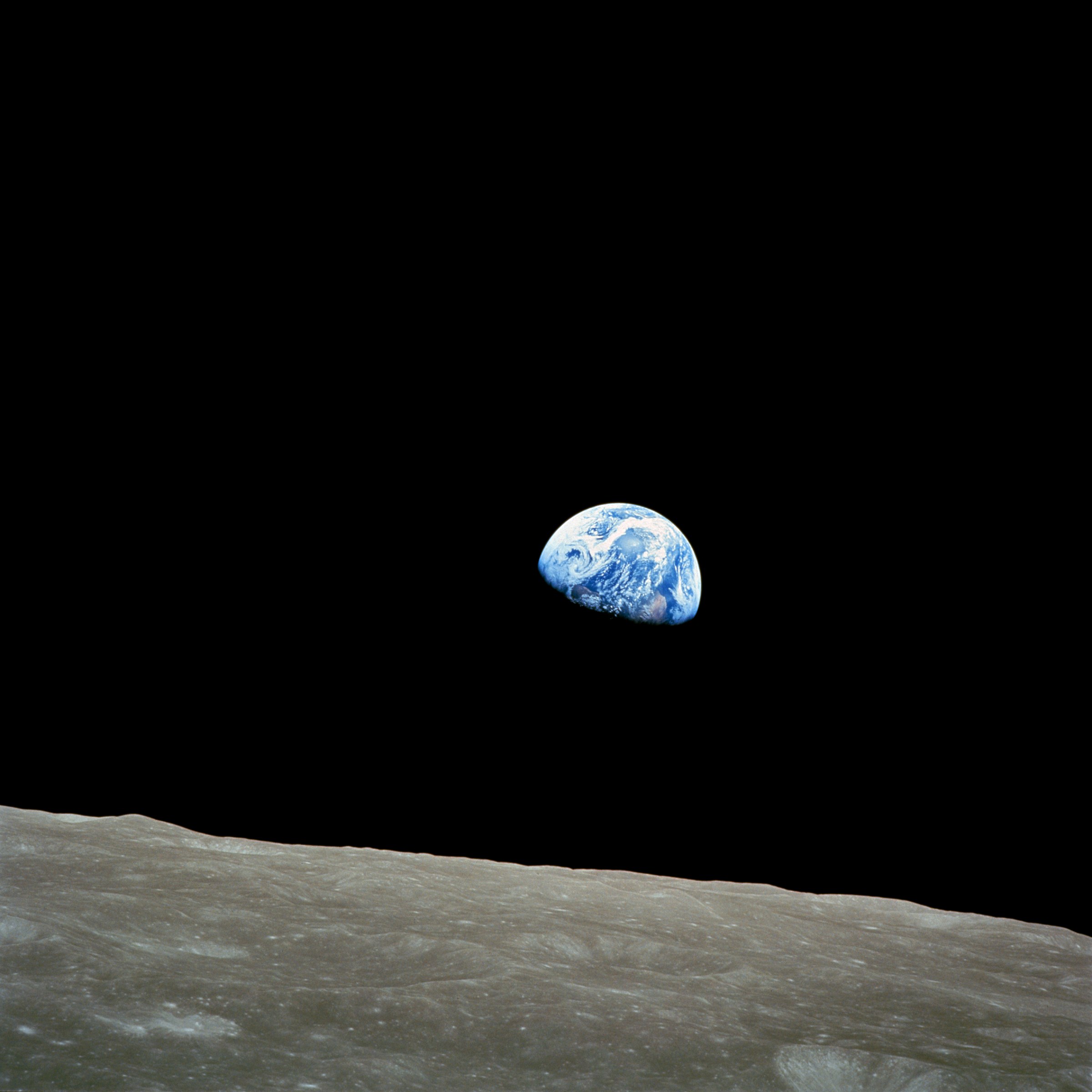
Fifty years ago, this week—just three days before Christmas 1966—NASA announced the names of a group of astronauts who would begin the final stages of America’s bold goal of planting bootprints on the Moon before the end of the decade. Crews were already deep in training for prime and backup positions on the Apollo-Saturn (AS)-204 mission, also known as “Apollo 1,” which would put the Command and Service Module (CSM) of the United States’ newest piloted spacecraft through its paces in low-Earth orbit in spring 1967. And with the announcements of the Apollo 2 and Apollo 3 prime and backup crews on 22 December 1966, NASA identified the men who might someday travel to lunar orbit and walk the Moon’s barren surface. Those crews, and the missions they would go on to perform later in their careers, would enjoy ringside seats for the most audacious exploration effort ever undertaken in human history.
As detailed in yesterday’s AmericaSpace history article, Apollo 2 and Apollo 3 were identified by their program designators. The former was known internally as AS-205/208 and took the form of a “double mission.” AS-205 would begin with the launch of a Command and Service Module (CSM), atop a Saturn IB booster, carrying astronauts Jim McDivitt, Dave Scott, and Rusty Schweickart. Twenty-four hours after McDivitt’s crew reached low-Earth orbit, AS-208 would roar aloft, using an identical Saturn IB, laden with an unpiloted Lunar Module (LM). The crew would rendezvous with the AS-208 vehicle, extract the LM from the booster’s S-IVB second stage, and perform joint operations over several days. Specifically, McDivitt and Schweickart would transfer from the CSM to the LM, undock and perform extensive tests of the lunar lander’s descent and ascent engines, as well as evaluate the Apollo lunar surface EVA suit. They would then redock with Scott in the CSM, discard the LM, and return to Earth after a mission lasting between five and 11 days.
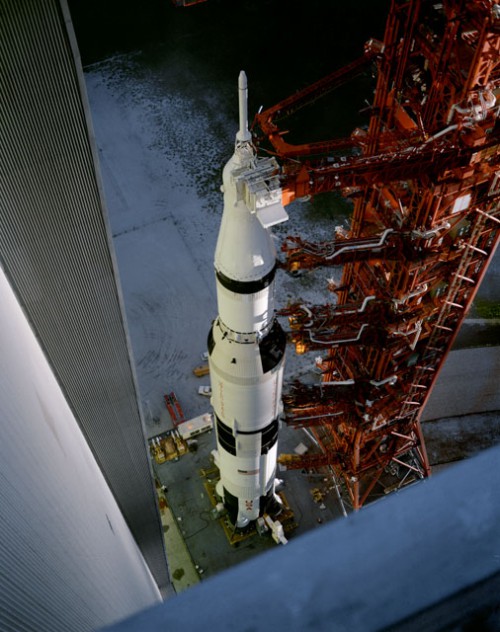
On the eve of the Apollo 1 fire, 26 January 1967, it was expected that as many as three manned missions might be launched by the United States that year. Astronauts Virgil “Gus” Grissom, Ed White, and Roger Chaffee would fly Apollo 1 for up to 14 days in the February-March timeframe, with McDivitt and his men targeted to fly Apollo 2 sometime around August. Then, perhaps as soon as December 1967, the third mission—designated “AS-503,” indicative of the fact that it would be the third production flight of the mammoth Saturn V booster—would deliver astronauts Frank Borman, Mike Collins, and Bill Anders on a voyage which would carry them farther from Earth than any humans ever before.
The previous highest altitude reached by astronauts was 850 miles (1,370 km), attained by Gemini XI crewmen Charles “Pete” Conrad and Dick Gordon in September 1966. Yet on Apollo 3, Borman, Collins, and Anders would launch atop the largest and most powerful rocket ever brought to operational status, entering a highly elliptical Earth orbit, with an apogee of close to 4,000 miles (6,400 km). “Mission plans also call for a maximum-distance rendezvous with the LM,” NASA noted, “with the LM rendezvousing with the CSM from a distance of several hundred miles.” Previously, on Gemini X in July 1966, Collins had set another altitude record of 475 miles (764 km), which offered him the opportunity to become the first astronaut to set two personal world spaceflight altitude records. “I would regain my former altitude record,” he wrote in his memoir, Carrying the Fire, “and then some!” It would provide Borman, Collins, and Anders with the opportunity to see “the entire Earth” and to do so “from pole to pole.”
To a significant degree, Apollo 3—subsequently labeled the “E-mission,” under NASA’s seven-step process to achieve American boots on the Moon before 1970—would closely mirror the trajectories to be taken on future lunar voyages. After being boosted into low-Earth orbit by the Saturn V, the booster’s restartable S-IVB third stage would ignite on a second occasion to deliver them into a highly elongated ellipse around the Home Planet. “This little detail created all sorts of planning problems,” Collins recounted in Carrying the Fire, “because one could only escape from this lopsided orbit at certain prescribed intervals and if one had troubles and was forced to return to Earth prematurely, it was entirely possible to end up landing in Red China.”
Had Apollo 3 flown as intended, close parallels could be drawn with the inaugural Exploration Flight Test (EFT)-1 mission of NASA’s Orion spacecraft in December 2014. But of course the dual-launch of AS-205/208 and the high-apogee test flight of AS-503 did not come to pass—at least not in their original incarnation. Within weeks of the Apollo 1 fire the crews were disbanded, and it was not until 20 November 1967 that further announcements were made by NASA. The McDivitt and Borman crews remained intact, with some adjustments to their backup crews, but the most notable change was a shift in the AS-205/208 mission configuration. Rather than flying the CSM and LM atop two separate Saturn IBs, McDivitt, Scott, and Schweickart would fly the entire spacecraft to low-Earth orbit in the fall of 1968 … on the first piloted voyage of the Saturn V. Meanwhile, Borman’s high-apogee mission with Collins and Anders would then take place in early 1969.
However, 1968 proved a changeable year. With CIA intelligence reports hinting that the Soviets were positioning themselves for a piloted lunar-orbital mission of their own, efforts entered high gear to bring Apollo into operations and deliver on the late President John F. Kennedy’s goal. In the spring of 1968, Apollo officials at the Manned Spacecraft Center (MSC) in Houston, Texas, were trying to upgrade the E-mission into something called “E-prime,” which would move the mission to the vicinity of the Moon. Instead of peaking at 4,000 miles (6,400 km), there were discussions of increasing the apogee of Borman’s crew to 240,000 miles (370,000 km)—effectively a circumlunar voyage. Before this could be concluded, in July 1968, Mike Collins was playing handball and realized that his legs did not seem to be functioning as they should. The condition worsened, with buckling knees, tingling, and numbness; a doctor’s examination led to a referral to a neurologist, who diagnosed a bony growth between his fifth and sixth cervical vertebrae, pushing against his spinal column. Surgery was the only option, which forced Collins to relinquish his position on Borman’s mission.
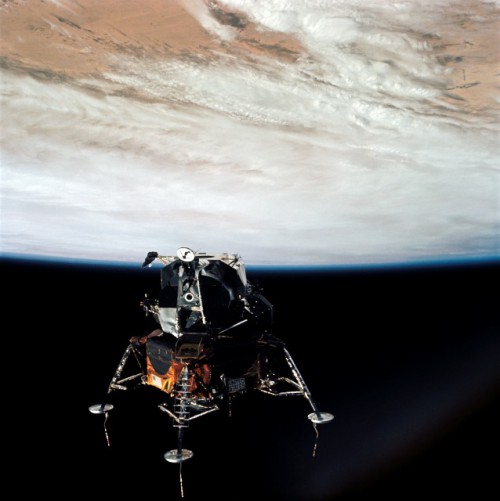
Collins was quickly replaced in the first week of August by veteran astronaut Jim Lovell and, within a few days, the E-mission changed beyond recognition. The Saturn V had been successfully test-flown and an increasingly emboldened NASA began a process of discussions to expedite Borman’s flight from a high-apogee Earth orbit … to lunar distance. Unfortunately, the LM itself was running behind schedule, and on 19 August NASA announced that the lunar lander would be dropped from Borman’s mission entirely. It was noted that planning for “an alternate Command and Service Module mission” would take place, “for launch in December.”
That “alternate” mission—for a crewed Apollo CSM to travel a quarter-million miles (370,000 km) from Earth to lunar orbit—did not formally enter the public domain until after Apollo 7 had successfully trialed the new spacecraft in a crewed capacity in October 1968. Borman’s revised flight, known internally as “C-prime,” became known to history as “Apollo 8.” In late October, NASA announced that it was “giving serious consideration” to three alternate mission possibilities for Apollo 8: a high-apogee Earth-orbital flight of up to 60,000 miles (96,560 km), a circumlunar flyby, or a full-up voyage into orbit around the Moon. By mid-November, the lunar-orbital goal had been confirmed and for a few days in December 1968, Borman, Lovell, and Anders earned worldwide renown as they spent Christmas Eve in orbit around the Moon.
And what of Jim McDivitt’s flight with the first lunar module? Delayed until the following spring, the mission which originated as the dual-launch AS-205/208 eventually roared aloft atop the second piloted Saturn V in March 1969. Although it has come to be regarded as the unsung hero of the program, Apollo 9 enabled the increasingly more difficult steps which followed by demonstrating the complete CSM and LM spacecraft in low-Earth orbit.
This is part of a series of history articles, which will appear each weekend, barring any major news stories. Next week’s article will look back at how Christmas has been celebrated in space over almost five decades.
Be sure to “Like” AmericaSpace on Facebook and follow us on Twitter: @AmericaSpace




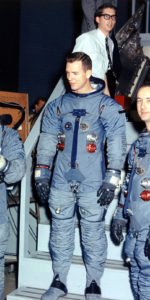
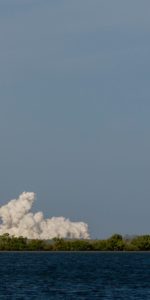
Fascinating piece of Apollo history. I believe that the Soviets were planning a lunar flyby, not a lunar orbital mission.A series of Zone spacecraft tested the abilities of a manned Soyuz ship to perform such a mission in early December 1968.
Thank you Ben Evans! Your excellent Apollo historical articles are appreciated!
We have lots of useful resources and other opportunities waiting for us on the Moon.
However:
“Our space program requires clear direction, decisive leadership and competent technical implementation. We need for those who understand this – those willing to pursue these vital tasks – to speak up, engage and make our space program great again.”
From: ‘Restoring America’s Space Program: An Ambitious But Achievable Path’
By Paul Spudis December 20, 2016
At: http://www.spudislunarresources.com/blog/restoring-americas-space-program-an-ambitious-but-achievable-path/
“Finally, and perhaps most importantly, Spudis says, the Moon has utility both as a source of rocket fuel and for geopolitical reasons. The discovery of water ice at its poles offers the potential to create an outpost near one or more of these areas. Because of the Moon’s orbital geometry, the orientation of its spin is nearly perpendicular to the plane of the ecliptic. (By contrast, Earth has an obliquity of 23.4 degrees, resulting in our four seasons.) This means that, at the Moon’s poles, some areas within the craters remain permanently shadowed, whereas, just a few kilometers away, slight rises in the lunar surface receive sunlight 90 percent or more of the time.”
From: ‘NASA’s next stop—Mars or the Moon?
John Grunsfeld and Paul Spudis argue for and against Mars and the Moon.’
By Eric Berger 12/22/2016
At: http://arstechnica.com/science/2016/12/time-to-choose-between-the-moon-and-mars-or-nasa-isnt-going-anywhere/?comments=1&start=280
We can use the Moon’s resources to help develop Cislunar Space or we can do flags and footprints on Mars.
Which has more potential to benefit taxpayers and provide high tech jobs for folks in America and around the world?
What do our international space exploration partners want to do next?
Where do American businesses want to go next?
Which is more affordable and doable?
We can talk about space history, technology, science, development, and colonies, but in the end it comes down to politics to pay for the development and launch of that needed space technology.
The national and international politics of space cannot be ignored.
“Once more, Russia has conducted a successful test of an anti-satellite weapon, Pentagon officials said Thursday.”
And, “It was the fifth time the weapon, a PL-19 Nudol missile, had been tested. Some military analysts have expressed concern over the test, saying that it was a provocative demonstration of Moscow’s might on a relatively new military frontier: outer space. But they suggest that it’s more about Russian posturing than an imminent threat. ”
From: ‘Russia launches anti-satellite weapon: A new warfront in space?’
At: By Weston Williams Christian Science Monitor December 23, 2016
At: https://www.yahoo.com/news/russia-launches-anti-satellite-weapon-warfront-space-204642910.html
Also:
“‘The United States must greatly strengthen and expand its nuclear capability until such time as the world comes to its senses regarding nukes,’ Trump tweeted.”
And, “In 2010, Obama and Russia’s then president Dmitry Medvedev signed the so-called New START treaty that calls for a significant reduction in the nuclear arsenals of both countries.”
And, “Trump’s remark came after Putin declared, ‘we need to strengthen the military potential of strategic nuclear forces,’ while boasting about the Russian army’s performance in its Syria campaign.”
From: ‘Trump calls for increased US nuclear capabilities’
By Thomas Watkins AFP December 23, 2016
At: https://www.yahoo.com/news/us-must-greatly-strengthen-nuclear-capability-trump-180604600.html
Well, we could read these types of news articles for the next four years, or four decades, or just maybe we could instead focus the world’s space agencies and companies on tapping the Moon’s resources, building large Space Based Solar Power satellites, improving the Earth’s communication and observation options, resupplying satellites and spacecraft with propellant, building robust satellites, and developing Cislunar Space and doing those tasks at a lower risk and cost than continually trying to “strengthen the military potential of strategic nuclear forces” and build very large numbers of anti-satellite and anti-missile missile weapons.
Spending lots more money on the world’s militaries could mean a decrease in money that is available to build critically needed infrastructure in poor countries.
If we get significant infrastructure on the Moon and in the rest of Cislunar Space, we most likely would have the resources and capabilities to see quite early an incoming nasty asteroid or comet and be able to deflect or destroy it long before it gets near our Home Planet.
That peaceful Cislunar Space infrastructure and defensive capability against Near Earth Objects, or NEOs, could be much more useful and sensible than encouraging the world’s citizens to get ready to fight in a Cold War II/WW III or to run off and hide on Mars.
Protecting and developing the Earth and its neighbor the Moon is a wise plan.
For the record, other folks are wisely preparing to go to the Moon while NASA’s leadership twiddles its thumbs, talks big about highly risky, super costly, and unfunded Mars missions, and cannot make any real plans for tapping the Moon’s resources.
Note:
“Several observers have noted that the lander spacecraft is relatively large. The wet mass of the Chang’E 3 before landing on the Moon is about 3800 kg (8360 lbs); the wet mass of the Apollo Lunar Module Descent stage (the spacecraft equivalent to Chang’E 3) was 10,150 kg (22,375 lbs), more than two and a half times as big. Nonetheless, the Chang’E 3 lander can deliver a fairly large payload to the lunar surface, up to about 1700 kg (a bit more than 1.5 metric tons), a much greater capacity than necessary for the small rover (~120 kg) carried on this mission.”
From: ‘China, America and the Moon: Boldness and Abdication’
By Paul Spudis November 5, 2013 by Paul Spudis
At: http://www.spudislunarresources.com/blog/china-america-and-the-moon-boldness-and-abdication/
“As envisioned by Russian engineers, the human-rated lander would consist of the 11-ton descent stage carrying landing gear and the propulsion system responsible for the trip from lunar orbit to the surface. In the meantime, the 8.5-ton ascent stage will contain the crew cabin with all the life-support gear and the engine to blast off from the lunar surface and to get back to the orbit around the Moon.”
From: ‘Revealed: Russia’s Crewed Lunar Lander
For the first time since the end of the Moon Race, Russian engineers have quietly begun working on a lunar lander capable of carrying cosmonauts to the Moon.’
By Anatoly Zak Feb 3, 2016
At: http://www.popularmechanics.com/space/moon-mars/news/a19269/revealed-russias-manned-lunar-lander/
“Will Americans be content with sending a handful of astronauts to Mars, while China colonizes the Moon over our heads?”
From: ‘NASA’s next stop—Mars or the Moon?
John Grunsfeld and Paul Spudis argue for and against Mars and the Moon.’
By Eric Berger 12/22/2016
Or to put it differently:
Are Americans content with the plan of sending a handful of astronauts to Mars, while Russia, China, India, Japan, Canada, South Korea, Brazil, Iran, and Europe colonize “the Moon over our heads?”
“Testing not only military sensors, the Clementine mission made history when a bistatic radio frequency experiment using the Goldstone radio antenna in California showed evidence of water ice through enhanced circular polarization of the radio signal. The ice was at the poles of the moon in the dark shadows that never see light.”
And, “This single discovery should have immediately transformed America’s space program. Water ice not only represents a critical in situ resource for life support (air and water); it can be cracked into its components, hydrogen and oxygen, to create the same chemical propellant that powered the Space Shuttle. Even better, this chemical propellant sits at the poles of the moon, which receive almost constant sunlight for photovoltaic power, which is necessary crack the water into hydrogen and oxygen.”
And, “Competition for locations on the moon (the poles) and resources is inevitable. It must be stated that constitutionally, the U.S. government is required to provide for the common defense. This includes defending American military assets in space AND commercial assets in space, many of which have and will have a dual role of providing commercial and military capabilities. President Kennedy said, ‘Whatever men shall undertake, free men must fully share.'”
And, “America must forever be the preeminent spacefaring nation and the moon is a path to being so.”
From: ‘SPEECH: This is our Sputnik moment.’
By Congressman Jim Bridenstine November 7th, 2016
At: http://spacerenaissanceact.com/speech-this-is-our-sputnik-moment/
The Moon’s H2O, CO2, NH3, and many other resources offer a wide diversity of rocket propellant options.
“The transportable chemical reactor uses solar power to convert CO2 from the air and regenerative hydrogen from electrolysis into liquid fuels.”
And, “Dubbed the Soletair Project, the inner workings of the reactor are structured on a microscopic level to make it compact enough to fit into a shipping container. The system, which was created at Germany’s Karlsruhe Institute of Technology (KIT), will be commercialized by KIT spinoff company Ineratec and its developers claim it can produce gasoline, diesel and kerosene on demand.”
From: ‘Reactor that produces liquid fuel from CO2 in the air to be tested in portable pilot plant’ By Eric Mack November 10th, 2016
At: http://newatlas.com/carbon-dioxide-fuel-pilot-plant-finland-kit-ineratec/46362/?li_source=LI&li_medium=default-widget
What are our American space policy makers waiting for?
“Photofission through the application of an ultra-intense laser enables a much more controllable and scalable nuclear yield.”
And, “There are many advantages to applying photofission for nuclear pulsed space propulsion. Photofission has been demonstrated by readily available sources, such as natural uranium isotopes, lead, and thorium [13] [14]. As opposed to a difficult to regulate neutron flux, photofission is controlled based on the activation of the ultra-intense laser, which can also be remote to the propulsion system [2].”
And, “This pulsed nuclear propulsion strategy was presented as an alternative to traditional chemical propulsion configurations, such as the Saturn V launch vehicles. The preliminary objective was to transfer spacecraft to Venus and Mars even by the late 1960’s [4]. The advantage of the Project Orion configuration is the considerable energy density utilized for imparting kinetic energy to the spacecraft, such as through a thermonuclear detonation [3] [4].
From: ‘Project New Orion: Pulsed Nuclear Space Propulsion Using Photofission Activated by Ultra-Intense Laser’
By Robert LeMoyne and Timothy Mastroianni
At: http://file.scirp.org/pdf/JAMP_2016041311280742.pdf
Wow! Could we really use the photofission of Lunar “thorium” to power a New Orion nuclear pulse spaceship launched from the Moon?
A New Orion nuclear pulse spaceship would be a great way to quickly go from the Moon to Pluto!
Yep, there is even a rich “thorium” mining site available on the Moon to whoever gets there first and stakes a claim.
“The estimated thorium concentration reaches 5.3 µg/g (5.3 micrograms per gram) while the surrounding highland basalts only contain between 0 and 2 µg/g. Compared to the Earth’s thorium concentration of 0.06 µg/g, the Compton–Belkovich’s is very high.[4]”
From: ‘Compton–Belkovich Thorium Anomaly’ Wikipedia
At: https://en.wikipedia.org/wiki/Compton%E2%80%93Belkovich_Thorium_Anomaly
Well, it seems our President, NASA, Congress, and the Defense Department have decided that Americans and our robots shouldn’t mine the ‘Compton–Belkovich Thorium Anomaly’ and sell the thorium to whomever wants to use it for enabling the “photofission for nuclear pulsed space propulsion”.
Yep, we currently buy access to the International Space Station and Rd-180 rocket engines for the Atlas V launcher from Russia and so our President, Congress, NASA, and the Defense Department are apparently “OK” and “onboard” with our space policy of someday buying Lunar “thorium” from a Russian ‘Compton–Belkovich Thorium Anomaly’ mine for our photofission of thorium nuclear pulsed spaceships.
We could buy built on the Moon New Orion thorium powered nuclear pulsed spaceships from Russia, too!
Maybe we could also avoid the costs of buying built on the Moon New Orion nuclear pulse spaceships and Lunar thorium from Russia and instead just buy some seats on future Russian owned nuclear pulse spaceships headed out to explore and colonize Ceres, Mars, and the moons of Jupiter and Saturn!
What a brilliant and cost saving ‘ignore the Moon’ space policy our wise leaders have devised!